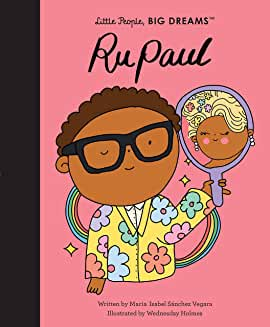
Little People, Big Dreams’ recent picture book biography, simply called RuPaul, is written by Maria Isabel Sánchez Vegara and illustrated by Wednesday Holmes. The cover features a visual trope often found in picture books about transgender characters. A young Ru with short hair wears masculine, albeit flamboyant clothes. The child holds up a mirror. It reflects a pink-cheeked Ru with wavy blond hair and pretty earrings. In picture books about transgender girls and boys, women and men, this type of image provides readers access to how transgender characters perceives themselves versus how they are perceived by others. The image doesn’t really function the same way in this picture book about renowned drag queen RuPaul, and I’m unsure how to read it.
Once I moved beyond the cover, I liked the book quite a bit. Ru is portrayed as a child confident and bold enough to project his unique take on fashion and gender into the world. For instance, in the book’s opening image, a young Ru is depicted sitting inside a wardrobe. He wears earrings, blue pants, and a green shirt decorated with a rainbow. Text on the facing page provides biographical information about where he grew up (San Diego) as well as who he grew up with (his mother and three sisters). His family is depicted in an image looking at the queerly dressed Ru; hearts surround them demonstrating their love for the child.
Ru is depicted wearing a mix of feminine and masculine clothes in all subsequent images. This appears to demonstrate that Ru was comfortable with his gender expression and the clothes used to construct his unique sense of fashion, even at a young age.
However, similarly to the cover, a trope often found in books about transgender and nonbinary youth is awkwardly plopped into the text. Two facing-pages, one featuring Ru “playing dress-up,” the other representing Ru “in real-life” are juxtaposed. Transgender and nonbinary youth as well as effeminate boys are often described as “playing dress-up” to contain their nonnormative gender expression within the realm of make-believe. However, in this book, Ru is wearing feminine attire and a has a smile on his face in both images. The difference between “play” and “real-life” is the presence of gawking children in the “real-life scenario.” I’m not sure what to make of this; especially since Ru seems unaware and undaunted by the children.
The following two-page spread shows Ru’s mother lovingly standing behind him, arms wrapped around her child. The text solidifies a message of love as the author notes that Ru’s mom taught him to love himself and do what made him happy. The image and sentiment remind me of one in Cheryl Kilodavis’s My Princess Boy.
Later images show an older Ru dressed in clothes that defy binary gender expectations while singing in a punk band and attending parties in New York City.
A subtly revised replica of the cover image appears around midway through the text. It is the first of a two-page spread, which depicts a dreamy bedroom with pale green walls and a bubble gum pink floor. This time, it is an adult Ru who looks into the mirror he is holding. He wears a yellow suit with large flowers and pink heels as the young Ru did on the front cover. The image in the mirror is of a woman with blond hair, earrings, and elaborate makeup. The room contains a table scattered with makeup and a table with several wigs. The accompanying text explains that drag was a way for Ru to express himself as an artist. Sanchez Vegara writes: “He mixed a spoonful of everything he loved and admired, and put his heart into becoming the woman of his dreams.” Subsequent images depict Ru in both feminine and masculine attire, and the author notes he is just as comfortable in each.
The book goes on to represent Ru’s many career successes from singing to modeling. The popular television RuPaul’s Drag Race is also represented. The author notes that “thousands of lonely kids … felt that they had finally found their people.” This is my favorite two-page spread. It depicts a living room with several children watching Rupaul’s Drag Race, showing how the television program brought drag into American households, introducing it to children, and providing a sense of community and affirming identity for queer youth.
Overall, I like this book very much. I found a couple choices odd, but the picture book is quite enjoyable, and it does a great job representing a happy confident queer child who grows into an awesome queer adult.
Leave a comment